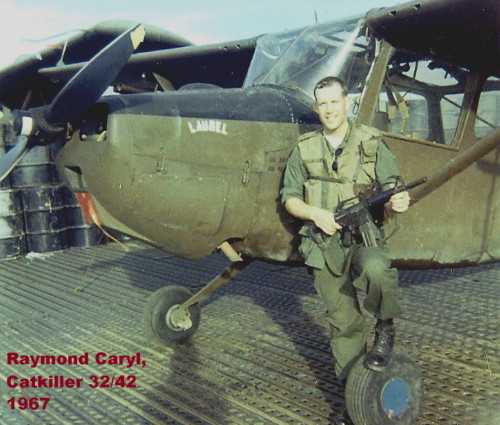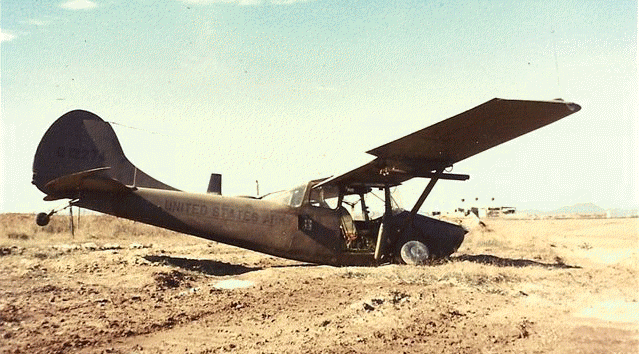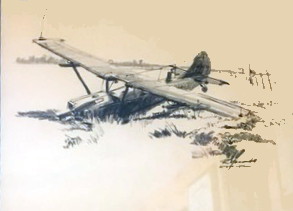Crash Landing at Dong Ha
(Or why I am not particularly fond of helicopters Part 2)
by Raymond Caryl, Catkiller 32/42, 1967—68

During the spring of 1968, the 1st Cav moved into northern I Corps to begin Operation Pegasus and relieve the Marines at Khe Sanh. They staged out of Dong Ha. I think every aircraft the Cav owned had a big yellow 1st Cav patch painted on it, or at least it seemed that way. Iím sure it didn´t take long for the NVA to figure out who the new kids on the block were and who they would soon be up against.
At that time, the First and Fourth Platoons were both flying out of Dong Ha. The First had recently been moved up from Quang Ngai. Still, there were days when we were flying the DMZ that one of our Bird Dogs might be the only aircraft visible for miles, with an occasional flight of fixed wing that we were controlling or, off in the distance, a lone Marine CH—46 or CH—34. You can imagine how cluttered the sky became when the Cav and its seemingly hundreds of helicopters showed up, like bugs around a porch light on a summer evening!
Immediately after Operation Pegasus wound down, two battalions of NVA moved south across the Ben Hai River into "Leatherneck Square," south of Con Tien, Alpha 3 and Gio Linh, and north of Dong Ha, over the span of two or three nights. The trails grew to be almost as wide as a country road and the packed dirt was shiny. A few days later, the ARVN Rangers were on a sweep south of Con Tien and ran into the NVA. One hell of a battle ensued. The 1/9 Air Cav (the wildest bunch of young killers you will ever encounter) pounced and the battle raged.
I was flying an artillery adjustment mission with a lieutenant backseater out of the 108th Arty based at Camp Carroll. I watched two 1st Cav H—13 helicopters cross in front of me from right to left at my altitude (1000ft AGL), then disappear from my vision (and pretty much from conscious thought as we were busy) to my left rear. A minute or so later, as I initiated a left turn, something impacted my Bird Dog with bone jarring force.
Holy Crap!
I immediately went straight and level, checked my instruments and controls, goosed the throttle a couple of times—everything OK—then checked to my left: tail, wing, wing strut—all there. To my right: Tail, backseater with eyes as big as saucers, wing, wing strut, right landing gear—OK.
Wait a minute! Right landing gear—NO left landing gear!
Something had ripped the left landing gear completely out of my Bird Dog. That´s when I noticed just one H—13 off in the distance and what looked like trails of white phosphorous forming a plume in the sky right about where the other H—13 should have been.
Now thoughts of structural failure crept into my mind—letís see, the wing strut is connected to the bulkhead directly above where the landing gear strut is attached. Something impacting my aircraft with enough force to rip the landing gear strut from the bulkhead surely jeopardizes the integrity of the wing strut attachment, and if that fails, there is a good chance that my left wing will fold up and I will fall from the heavens—not good.
We closed out with our artillery battery, headed immediately for Dong Ha some ten or so miles away and told the tower to alert crash rescue.
Due to the heavy combat just north of Dong Ha, the single—runway airfield was extremely busy. Everything from Hueys to C-130s were landing and taking off in a nonstop procession. Knowing that I would ground loop with only one main landing gear and concerned about fire as my aircraft scraped along on the grit—impregnated alloy—panel runway, I elected to "land" in the dirt right beside the runway.
The gods were smiling that day. Not only did whatever—it—was that flew from the exploding H—13—and it had to be heavy, hit me in just about the only place that wouldn´t have killed me and my backseater outright or completely destroyed my Bird Dog in flight, there also just happened to be an old, abandoned foxhole right beside the runway that I did not see. I touched down in a three point pitch-attitude (actually, two) and just as the lift in my left wing was departing and it started to drop, the right landing gear rumbled across and down into the foxhole, tearing the right landing gear rearward, resulting in a belly slide of a hundred feet or so and no ground loop! As I said, the gods were smiling. Crash showed up, shot some foam on the ground where the fuel that was running out of the tanks was accumulating and we stood around amazed that we had survived.

An hour or so later, I was summoned to the GP medium tent where the Major who commanded the 1/9 Cav was sitting behind a small field desk. After reporting to him, he grilled me briefly on what had happened, I think ensuring that I had not mid—aired with one of his helicopters. He was a cold, all business character, and when I said that I was sorry that he had lost one of his aircrews, he told me that the 1/9 Cav "expected losses" and to "get the hell out of his tent."
I saluted, about faced, got the hell out of his tent and silently thanked God that I was in the 220th RAC flying Bird Dogs and not flying helicopters for the 1/9 Cav. I suppose he had to be hard core to command an aviation unit that was constantly losing pilots and aircraft, but he seemed like a certifiable asshole to me. Later, at Ft. Rucker, I had a bud who had flown H—13s for the 1/9 Cav and had SEVEN of them shot out from underneath him and survived—but his story is best told over several very tall, very cold ones.
Epilogue:
The CO, Major Pederson, and a certain Captain whose name I shall not reveal (the story of our personal encounter resides in another tale), arrived in the company Beaver shortly after my encounter with the 1/9 Cav Major to ascertain the particulars and return me to Phu Bai. As one might imagine, I was still somewhat in a state of hyper—tension, considering I had not only nearly been knocked out of the sky, but thrown out of a GP medium to boot—insult to injury. Thus, the following did not set well: The first thing out of the Captainís mouth (and of course, in ear-shot of the CO) upon arriving at the site of my now totaled, almost new Bird Dog (O1–G, 0–12274) was, "So, Captain Caryl, low-leveling AGAIN, huh?" Sheesh!..........just another day on the "Z".
Ray Caryl, CatKiller 32/42
Reflecting Back in 2022: The Rest Of The Story:
by Raymond Caryl, Catkiller 32/42, 1967—68
That fateful day in June 1968 began in a rather surprising way. I strolled out to my aircraft that was tied down in the revetments getting ready to fly my second mission for the day. There was a young Marine Lance Corporal sitting on a small folding stool in front of my Birddog, sketching it with a charcoal pencil. I struck up a conversation with him and found out that the was a USMC Combat Artist.
This was interesting news to me as I didnít know there was such a thing. He told me that he had complete freedom of movement to create art showing Marine activities and that he often hitched rides on helicopters flying out to Khe Sanh, tagged along on Marine patrols or went unaccompanied into Vietnamese villages to draw the locals as they went about their daily activities. Needless to say, I was impressed, especially to hear that he went voluntarily back and forth to Khe Sanh as it had been under siege by the NVA since January and was a very dangerous place.
I told him that I was scheduled to fly a mission right then, but if he would wait around for 2 1/2 hours, I would like to buy a sketch of my Birddog from him. He agreed and off I went, neither of us realizing that I would be returning with a severely damaged aircraft.
Less than an hour later I crash landed back at Dong Ha. Both my Marine observer and I survived without a scratch, but my poor little Birddog was completely missing the left landing gear. The right landing gear and strut were torn loose from its attaching point on the primary bulkhead and splayed out alongside the fuselage. Fuel was leaking from the fuel tanks in the wings and the aircraft was probably unrepairable.
Crash Rescue had sprayed foam on the puddles of fuel on the ground under the wings and then, deeming their job complete, left the scene. Fortunately, I had chosen to land beside the single runway and not on it, so there was no disruption of landings and takeoffs of other aircraft.
Shortly, the young Marine Combat Artist showed up and unfolding his little stool, began sketching my Birddog lying sadly in the dirt. He used the same piece of art paper that he had begun drawing my Birddog on back in the revetments. He simply flipped the paper over and drew in the other side.
The Marine Lance Corporal’s name is Richard Yaco. He is an accomplished and well known artist. You can Google his name and see some of his beautiful paintings. You can also go to a US Marine Recruiting station and look through books of USMC Vietnam combat art. There you will find many of his drawings.
I was able to reconnect with Richard several years ago, and I can proudly say that I have an original Richard Yaco drawing framed and hanging on my wall.
Drawing by Richard Yaco, 1968:







